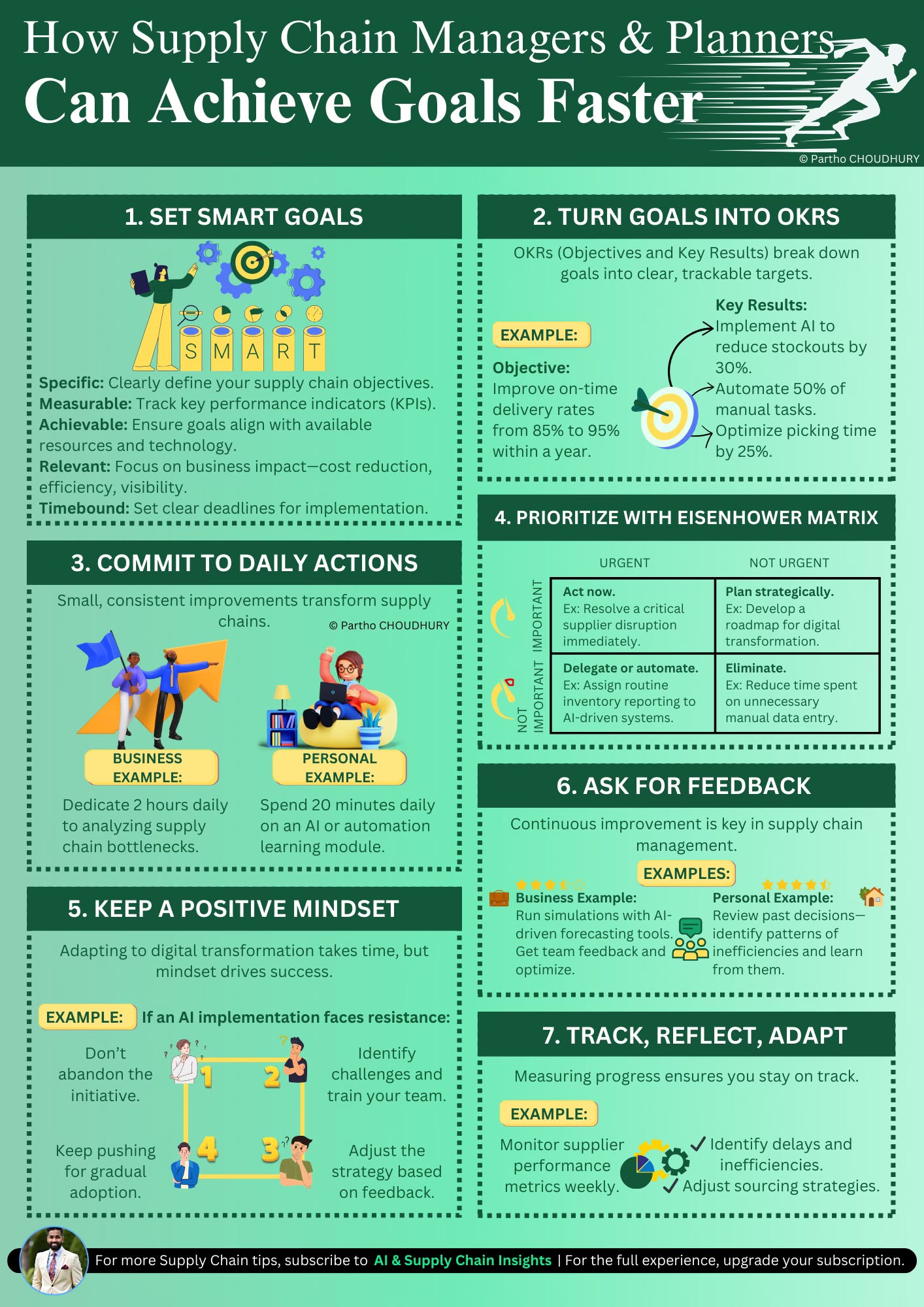The Future of Supply Chain: From Manual Chaos to AI-Driven Excellence
Why Supply Chain Managers Must Evolve—Now
Imagine this: You start your day firefighting delays, responding to supplier issues, and manually updating spreadsheets. By the time you wrap up, there’s little progress—just another day lost in inefficiencies.
Sound familiar?
The world of supply chain management is shifting. AI, automation, and real-time analytics are revolutionizing the industry. Yet, many supply chain managers and planners remain trapped in outdated manual processes. The future doesn’t wait—and those who don’t adapt will be left behind.
It’s time to transform. Here’s how.
1. Set SMART Goals for Supply Chain Optimization
Success in supply chain management starts with clarity. Vague goals like “improve efficiency” won’t cut it. Instead, set SMART (Specific, Measurable, Achievable, Relevant, Timebound) goals.
✅ Specific: Define exactly what you want to improve.
✅ Measurable: Use key metrics like lead time, fulfillment rates, and costs.
✅ Achievable: Base goals on data, not guesswork.
✅ Relevant: Align them with business needs—cost reduction, speed, and visibility.
✅ Timebound: Set a deadline for completion.
🔹 Example Goal: Reduce warehouse lead time by 20% in six months through AI-driven demand forecasting.
This method turns wishful thinking into measurable progress.
2. Turn Goals into OKRs (Objectives & Key Results)
OKRs break down broad objectives into actionable results.
🔹 Objective: Improve on-time delivery rates from 85% to 95% within a year.
🔹 Key Results:
Use AI-driven forecasting to reduce stockouts by 30%.
Automate 50% of manual order processing tasks.
Optimize warehouse layouts to reduce picking time by 25%.
OKRs keep your team aligned and results-driven.
3. Commit to Daily Actions—Small Steps, Big Impact
Massive transformation doesn’t happen overnight. But small, consistent actions drive real progress.
📌 Business Example: Dedicate 2 hours daily to analyzing supply chain bottlenecks. Use AI dashboards for real-time logistics tracking.
📌 Personal Example: Spend 20 minutes daily learning about supply chain tech advancements. The industry is evolving—stay ahead.
Consistency beats motivation. Build habits that drive long-term success.
4. Prioritize with the Eisenhower Matrix
Not all tasks are equal. Use the Eisenhower Matrix to focus on what matters:
🟢 Urgent & Important: Solve supplier disruptions immediately.
🟡 Urgent & Not Important: Automate or delegate routine inventory reporting.
🔵 Not Urgent & Important: Schedule time for long-term AI adoption strategies.
🔴 Not Urgent & Not Important: Cut time wasted on manual data entry.
Efficiency isn’t about doing more—it’s about doing what matters.
5. Keep a Positive Mindset in the Face of AI Adoption
Change isn’t easy. Many supply chain professionals resist AI and automation because they fear complexity.
🚀 Mindset Shift: If an AI implementation struggles:
Don’t abandon it—refine your approach.
Identify bottlenecks and provide team training.
Adjust rollout strategies based on real feedback.
Keep pushing—gradual adoption beats stagnation.
The winners in supply chain management aren’t those who resist change, but those who embrace it.
6. Seek Feedback to Improve Faster
The best supply chain managers aren’t lone wolves—they seek feedback constantly.
📌 Business Example: Run simulations with AI-driven forecasting. Compare results with traditional methods. Adapt accordingly.
📌 Personal Example: Review past procurement decisions—identify inefficiencies and learn from them.
Feedback isn’t criticism—it’s a shortcut to improvement.
7. Track, Reflect, and Adapt
What gets measured gets managed. Supply chain transformation requires continuous tracking and adjustment.
📊 Example: Monitor supplier performance weekly.
✔ Identify delays and inefficiencies.
✔ Adjust sourcing strategies to optimize operations.
📌 Action Step: Reallocate resources to top-performing suppliers and logistics partners.
The Future is Now—Will You Lead or Lag?
Supply chain management is at a turning point. Those who cling to manual processes and outdated strategies will struggle. But those who embrace AI, automation, and real-time analytics will thrive.
The choice is yours:
❌ Keep drowning in inefficiencies.
✅ Step up and lead the digital revolution in supply chain management.
🚀 The future of supply chains is AI-driven. Are you ready to adapt?





